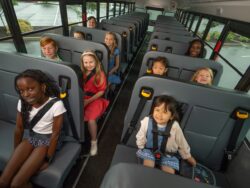In a first for the school bus industry, bus maker Blue Bird Corporation has announced that, starting this year, lap-shoulder seat belts will be standard equipment for all seating positions on all of the company’s school buses.
The news marks a major step forward for CPS, as an estimated 25 million U.S. children ride school buses each day. For their safety, SRN and organizations like the National Transportation Safety Board, the American Academy of Pediatrics, and the National Safety Council have long urged that the buses that carry these children be equipped with seat belts.
In 2015, then-NHTSA administrator Mark Rosekind added NHTSA’s voice to this conversation, stating in a speech and press release that the agency agrees that school buses ought to have lap-shoulder seat belts. (See SRN Nov/Dec 2015.) The agency acknowledged that, while the required occupant protection method of compartmentalization works well for properly seated passengers in frontal and rear crashes, the addition of lap-shoulder belts would provide better protection, especially in side-impact and rollover crashes.
Despite the strong affirmation, NHTSA stopped short of creating a regulation to require lap-shoulder belts on large school buses (those weighing over 10,000 pounds). Although NHTSA’s stance may have contributed to a few more states enacting laws requiring seat belts in all buses—bringing the current total of states with laws to seven—the vast majority of states have no such law. More recently, however, the legislative pathway—the main focus of advocacy over the years—has been stagnant, as efforts to pass laws have been unsuccessful.
Therefore, Blue Bird’s new policy represents a novel approach that invigorates the decades-long movement to better protect school bus passengers. Blue Bird, the company credited with creating the first commercial, purpose-made school bus back in 1927, is one of the U.S.’s three major school bus manufacturers. So, even just this one company making lap-shoulder belts standard equipment will add many school buses with this feature to the nationwide fleet.
Simultaneously, the company announced other safety improvements scheduled for 2025, including a steering-wheel mounted front air bag as standard equipment for driver protection. While lap-shoulder belts have long been required for school bus driver seats, these seats are exempt from air bag requirements, so this news signals another first for the industry.
IMMI, of Westfield, Indiana, will provide Blue Bird’s upgraded seating for both drivers and passengers. IMMI developed the first school bus seating with lap-shoulder belts in the early 2000s and, under the SafeGuard brand, makes integrated CSRS and add-on Star models for children. IMMI also makes many other products, including harness and LATCH components that are commonly used on CRs.
Blue Bird’s announcement states that it will add these safety features at no upcharge to the customer. This commitment is important because cost has long been a deterrent for equipping buses with seat belts. (See below for a summary of other pervasive, but debunked, arguments.) Blue Bird says it will continue to provide options for customers that wish to opt out of the upgraded seating, but those who do will be required to sign a waiver releasing Blue Bird from liability.
SRN hopes that Blue Bird’s leadership will spur other school bus manufacturers to follow suit. The availability of buses that are affordably equipped with lap-shoulder belts may also inspire more state legislatures to enact a law requiring seat belts and/or remove loopholes in their existing child occupant protection law so that seat belt use requirements apply to school buses when belts are present.
Myths vs. Reality: Lap-Shoulder Belts on Buses
As reported above, starting this fall, Blue Bird will equip all seating positions of new school buses with lap-shoulder seat belts. The belts will augment compartmentalization, the occupant protection approach required by FMVSS 222 for school buses over 10,000 pounds. Blue Bird has pledged to add the seat belts at no added cost to the consumer, eliminating a common concern about belts on school buses—cost.
However, other arguments against belts on buses continue to circulate despite being debunked through, largely, lived experience.
One source of evidence that contradicts these arguments is real-world application in California, where lap-shoulder belts are found on virtually every school bus because new buses have been required to have them for about 20 years. Also, a 2021 NHTSA study titled “Indirect Effects of School Bus Seat Belt Installation” reported similarly positive outcomes, stating, “Overall, the findings of this project indicate that seat belt use is associated with improved student behavior and reduced bus driver distraction.”
So, CPSTs should know the facts about lap-shoulder belts on buses:
Myth: Seat belts on buses will be vandalized and/or used as weapons.
Reality: There has been no data or reporting to suggest that these incidents occur more often on buses with seat belts. In fact, better student behavior may decrease such events.
Myth: Belts will slow emergency evacuation.
Reality: Lap-shoulder belt users are more likely to be conscious after a crash, and a conscious child is easier to evacuate.
Myth: A belted child will be trapped if the bus rolls over.
Reality: Seat belt buckles in school buses, as in other vehicles, are required to be operational under crash conditions. They are designed to be able to release even when loaded by the weight of a dangling child.
Myth: More buses must be purchased because seat belts reduce the capacity of each bus.
Reality: Today’s lap-shoulder belts allow three elementary or two high school students to be seated per 39-inch bench, which is the same capacity as on benches without belts.

